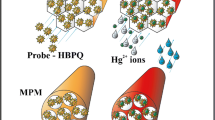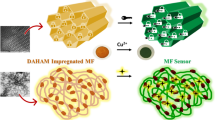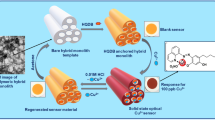Abstract
The article demonstrates the design of two solid-state sensors for the capturing of industrially relevant ultra-trace Co(II) ions using porous monolithic silica and polymer templates. The mesoporous silica reveals high surface area and voluminous pore dimensions that ensures homogeneous anchoring of 4-((5-(allylthio)-1,3,4-thiadiazol-2-yl)diazenyl)benzene-1,3-diol, as the chromoionophore. We report a first of its kind solid-state macro-/meso-porous polymer monolithic optical sensor from a monomeric chromoionophore, i.e., 2-(4-butylphenyl)diazenyl)-2-hydroxybenzylidene)hydrazine-1-carbothioamide. The monolithic solid-state sensors are characterized using HR-TEM-SAED, FE-SEM-EDAX, p-XRD, XPS, 29Si/13C CPMAS NMR, FT-IR, TGA, and BET/BJH analysis. The electron microscopic images reveal a highly ordered hexagonal mesoporous network of honeycomb pattern for silica monolith, and a long-range macroporous framework with mesoporous channels for polymer monolith. The sensors offer exclusive ion-selectivity and sensitivity for trace cobalt ions, through a concentration proportionate visual color transition, with a response kinetics of ≤ 5 min. The optimization of ion-sensing performance reveals an excellent detection limit of 0.29 and 0.15 ppb for Co(II), using silica- and polymer-based monolithic sensors, respectively. The proposed sensors are tested with industrial wastewater and spent Li-ion batteries, which reveals a superior cobalt ion capturing efficiency of ≥ 99.2% (RSD: ≤ 2.07%).
Graphical abstract








Similar content being viewed by others
References
Ullah N, Mansha M, Khan I, Qurashi A. Nanomaterial-based optical chemical sensors for the detection of heavy metals in water: recent advances and challenges. TrAC - Trends Anal Chem. 2018;100:155–66. https://doi.org/10.1016/j.trac.2018.01.002.
Zhang L, Peng D, Liang RP, Qiu JD. Graphene-based optical nanosensors for detection of heavy metal ions. TrAC - Trends Anal Chem. 2018;102:280–9. https://doi.org/10.1016/j.trac.2018.02.010.
Mudhoo A, Ramasamy DL, Bhatnagar A, Usman M, Sillanpää M. An analysis of the versatility and effectiveness of composts for sequestering heavy metal ions, dyes and xenobiotics from soils and aqueous milieus. Ecotoxicol Environ Saf. 2020;197:110587. https://doi.org/10.1016/j.ecoenv.2020.110587.
Li J, Guo L, Zhao N, Yang X, Yi R, Li K, et al. Determination of cobalt in low-alloy steels using laser-induced breakdown spectroscopy combined with laser-induced fluorescence. Talanta. 2016;151:234–8. https://doi.org/10.1016/j.talanta.2016.01.023.
Au-Yeung HY, New EJ, Chang CJ. A selective reaction-based fluorescent probe for detecting cobalt in living cells. Chem Commun. 2012;48:5268–70. https://doi.org/10.1039/c2cc31681a.
Liu Z, Jia X, Bian P, Ma Z. A simple and novel system for colorimetric detection of cobalt ions. Analyst. 2014;139:585–8. https://doi.org/10.1039/c3an01845h.
El-Safty SA, Prabhakaran D, Ismail AA, Matsunaga H, Mizukami F. Three-dimensional wormhole and ordered mesostructures and their applicability as optically ion-sensitive probe templates. Chem Mater. 2008;20:2644–54. https://doi.org/10.1021/cm701966c.
Zhu H, Fan J, Wang B, Peng X. Fluorescent, MRI, and colorimetric chemical sensors for the first-row d-block metal ions. Chem Soc Rev. 2015;44:4337–66. https://doi.org/10.1039/c4cs00285g.
Ryu KY, Lee SY, Park DY, Kim SY, Kim C. A novel colorimetric chemosensor for detection of Co2+ and S2− in an aqueous environment. Sensors Actuators B Chem. 2017;242:792–800. https://doi.org/10.1016/j.snb.2016.09.180.
Maity D, Govindaraju T. Highly selective colorimetric chemosensor for Co2+. Inorg Chem. 2011;50:11282–4. https://doi.org/10.1021/ic2015447.
Song EJ, Kang J, You GR, Park GJ, Kim Y, Kim SJ, et al. A single molecule that acts as a fluorescence sensor for zinc and cadmium and a colorimetric sensor for cobalt. Dalt Trans. 2013;42:15514–20. https://doi.org/10.1039/c3dt51635k.
Kang SM, Jang SC, Kim GY, Lee CS, Huh YS, Roh C. A rapid in situ colorimetric assay for cobalt detection by the naked eye. Sensors (Switzerland). 2016;16:1–10. https://doi.org/10.3390/s16050626.
Vashisht D, Kaur K, Jukaria R, Vashisht A, Sharma S, Mehta SK. Colorimetric chemosensor based on coumarin skeleton for selective naked eye detection of cobalt (II) ion in near aqueous medium. Sensors Actuators B Chem. 2019;280:219–26. https://doi.org/10.1016/j.snb.2018.10.020.
Liu Z, Wang W, Xu H, Sheng L, Chen S, Huang D, et al. A “naked eye” and ratiometric chemosensor for cobalt(II) based on coumarin platform in aqueous solution. Inorg Chem Commun. 2015;62:19–23. https://doi.org/10.1016/j.inoche.2015.10.017.
Awual MR, Yaita T, Shiwaku H, Suzuki S. A sensitive ligand embedded nano-conjugate adsorbent for effective cobalt(II) ions capturing from contaminated water. Chem Eng J. 2015;276:1–10. https://doi.org/10.1016/j.cej.2015.04.058.
Awual MR, Islam A, Hasan MM, Rahman MM, Asiri AM, Khaleque MA, et al. Introducing an alternate conjugated material for enhanced lead(II) capturing from wastewater. J Clean Prod. 2019;224:920–9. https://doi.org/10.1016/j.jclepro.2019.03.241.
Li M, Gou H, Al-Ogaidi I, Wu N. Nanostructured sensors for detection of heavy metals: a review. ACS Sustain Chem Eng. 2013;1:713–23. https://doi.org/10.1021/sc400019a.
Zhang L, Fang M. Nanomaterials in pollution trace detection and environmental improvement. Nano Today. 2010;5:128–42. https://doi.org/10.1016/j.nantod.2010.03.002.
Yao Y, Tian D, Li H. Cooperative binding of bifunctionalized and click-synthesized silver nanoparticles for colorimetric Co2+ sensing. ACS Appl Mater Interfaces. 2010;2:684–90. https://doi.org/10.1021/am900741h.
Karami C, Taher MA. Colorimetric sensor of cobalt ions in aqueous solution using gold nanoparticles modified with glycyrrhizic acid. Plasmonics. 2018;13:1315–23. https://doi.org/10.1007/s11468-017-0635-9.
Umair M, Javed I, Rehman M, Madni A, Javeed A, Ghafoor A, et al. Nanotoxicity of inert materials: the case of gold, silver and iron. J Pharm Pharm Sci. 2016;19:161–80. https://doi.org/10.18433/j31021.
Ferdous Z, Nemmar A. Health impact of silver nanoparticles: a review of the biodistribution and toxicity following various routes of exposure. Int J Mol Sci. 2020;21:2375 https://www.mdpi.com/1422-0067/21/7/2375.
Liu G, Lu M, Huang X, Li T, Xu D. Application of gold-nanoparticle colorimetric sensing to rapid food safety screening. Sensors (Switzerland). 2018;18:1–16. https://doi.org/10.3390/s18124166.
El-Safty SA, Prabhakaran D, Ismail AA, Matsunaga H, Mizukami F. Nanosensor design packages: a smart and compact development for metal ions sensing responses. Adv Funct Mater. 2007;17:3731–45. https://doi.org/10.1002/adfm.200700447.
Kongasseri A, Sompalli NK, Modak VA, Mohanty A, Nagarajan S, Rao CVSB, et al. Solid-state ion recognition strategy using 2D hexagonal mesophase silica monolithic platform: a smart two-in-one approach for rapid and selective sensing of Cd2+ and Hg2+ ions. Microchim Acta. 2020;187:403. https://doi.org/10.1007/s00604-020-04363-y.
Shahat A, Hassan HMA, El-Shahat MF, El Shahawy O, Awual MR. A ligand-anchored optical composite material for efficient vanadium(II) adsorption and detection in wastewater. New J Chem. 2019;43:10324–35. https://doi.org/10.1039/c9nj01818b.
El-Safty SA. Functionalized hexagonal mesoporous silica monoliths with hydrophobic azo-chromophore for enhanced Co(II) ion monitoring. Adsorption. 2009;15:227–39. https://doi.org/10.1007/s10450-009-9171-z.
El-Safty SA, Awual MR, Shenashen MA, Shahat A. Simultaneous optical detection and extraction of cobalt(II) from lithium ion batteries using nanocollector monoliths. Sensors Actuators B Chem. 2013;176:1015–25. https://doi.org/10.1016/j.snb.2012.09.040.
Awual MR, Alharthi NH, Hasan MM, Karim MR, Islam A, Znad H, et al. Inorganic-organic based novel nano-conjugate material for effective cobalt(II) ions capturing from wastewater. Chem Eng J. 2017;324:130–9. https://doi.org/10.1016/j.cej.2017.05.026.
Shahat A, Awual MR, Naushad M. Functional ligand anchored nanomaterial based facial adsorbent for cobalt(II) detection and removal from water samples. Chem Eng J. 2015;271:155–63. https://doi.org/10.1016/j.cej.2015.02.097.
Nischang I, Causon TJ. Porous polymer monoliths: from their fundamental structure to analytical engineering applications. TrAC - Trends Anal Chem. 2016;75:108–17. https://doi.org/10.1016/j.trac.2015.05.013.
Svec F. Porous polymer monoliths: amazingly wide variety of techniques enabling their preparation. J Chromatogr A. 2010;1217:902–24. https://doi.org/10.1016/j.chroma.2009.09.073.
Kongasseri A, Sompalli NK, Rao CVS, Nagarajan S, Mohan AM, Deivasigamani P. Solid-state optical sensing of ultra-trace Hg2+ ions using chromoionophoric probe anchored silica monolithic architectures. Sensors Actuators B Chem. 2020;321:128558. https://doi.org/10.1016/j.snb.2020.128558.
Ismail AA. A selective optical sensor for antimony based on hexagonal mesoporous structures. J Colloid Interface Sci. 2008;317:288–97. https://doi.org/10.1016/j.jcis.2007.09.028.
Gomaa H, Shenashen MA, Yamaguchi H, Alamoudi AS, El-Safty SA. Extraction and recovery of Co2+ ions from spent lithium-ion batteries using hierarchical mesosponge γ-Al2O3 monolith extractors. Green Chem. 2018;20:1841–57. https://doi.org/10.1039/c7gc03673f.
Madikizela LM, Zunngu SS, Mlunguza NY, Tavengwa NT, Mdluli PS, Chimuka L. Application of molecularly imprinted polymer designed for the selective extraction of ketoprofen from wastewater. Water SA. 2018;44:406–18. https://doi.org/10.4314/wsa.v44i3.08.
Morgan DR, Kalachandra S, Shobha HK, Gunduz N, Stejskal EO. Analysis of a dimethacrylate copolymer (Bis-GMA and TEGDMA) network by DSC and 13C solution and solid-state NMR spectroscopy. Biomaterials. 2000;21:1897–903. https://doi.org/10.1016/S0142-9612(00)00067-3.
Sompalli NK, Mohan AM, Rao CVSB, Nagarajan S, Deivasigamani P. Tailor-made porous polymer and silica monolithic designs as probe anchoring templates for the solid-state naked eye sensing and preconcentration of hexavalent chromium. Sensors Actuators B Chem. 2019;298:126896. https://doi.org/10.1016/j.snb.2019.126896.
Madhesan T, Mohan AM. Porous silica and polymer monolith architectures as solid-state optical chemosensors for Hg2+ ions. Anal Bioanal Chem. 2020;412:7357–70. https://doi.org/10.1007/s00216-020-02870-8.
Sompalli NK, Deivasigamani P. Structurally designed porous polymer monoliths as probe anchoring templates as benign and fast responsive solid-state optical sensors for the sensing and recovery of copper ions. Nanotechnology. 2020;31:414004. https://doi.org/10.1088/1361-6528/ab9e2a.
Acknowledgements
The authors thank Sri Sai Company for providing the scrap Li-ion battery and also CVR Labs for sample analysis.
Funding
This study was financially supported by SERB (SB/FT/CS-051/2014), and VIT (Institute Seed Grant 2019).
Author information
Authors and Affiliations
Corresponding author
Ethics declarations
Conflict of interest
The authors declare no competing interests.
Additional information
Publisher’s note
Springer Nature remains neutral with regard to jurisdictional claims in published maps and institutional affiliations.
Supplementary information
ESM 1
(PDF 1693 kb)
Rights and permissions
About this article
Cite this article
Sompalli, N.K., Deivasigamani, P. Fabrication of target specific solid-state optical sensors using chromoionophoric probe–integrated porous monolithic polymer and silica templates for cobalt ions. Anal Bioanal Chem 413, 3177–3191 (2021). https://doi.org/10.1007/s00216-021-03255-1
Received:
Revised:
Accepted:
Published:
Issue Date:
DOI: https://doi.org/10.1007/s00216-021-03255-1




